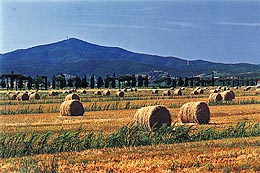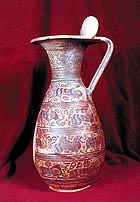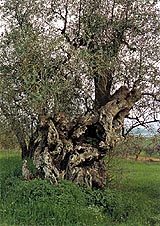We warmly advise you to visit the fascinating Etruscan Maremma which includes the following towns: Roselle, Populonia, Vetulonia, Massa Marittima (and the lake of Accesa), Talamone, Orbetello, Ansedonia, Marsiliana, Saturnia, Sovana and Pitigliano, all in the province of Grosseto. An area that stretches along the coast of the promontory of Piombino as far as the Argentario and, towards the interior, from the southern slopes of the Colline Metallifere to the valley of the Flora and the eastern slopes of Mount Amiata. The climate along the whole stretch of coast of the Maremma is as a rule very mild: the typical marine climate of the Mediterranean with temperate winters and cool and dry summers. The city of Grosseto, the towns of Massa Marittima, Follonica, Piombino, Punta Ala, Orbetello or one of the towns on the Argentario are ideal bases for visiting the Maremma. If you choose Grosseto, you can visit the Etruscan sites, the old town, the Cathedral (containing a baptismal font, the Madonna of Grace by Matteo di Giovanni (1430-1495)), the Church of San Pietro with its Romanesque apse and the Church of San Francesco with a Crucifix attributed to Duccio di Boninsegna (1255-1318) in his youth. The Archeological Museum (recently reopened) is also well worth a visit, containing important Etruscan exhibits, Prehistoric, Roman and Medieval remains, and paintings by Segna di Bonaventura (1298-1327), Donato Martini, and Sassetta (1400-1450).

What is the food like in the Maremma? It is just as good today as it was in the time of the Etruscans. The area has a long tradition of cattle breeding, especially that of rearing cattle in the wild, as well as fish, many of them bred in the lagoon of Orbetello. The Maremma has always been a good hunting zone and therefore wild boar, venison, pheasant and hare are almost always available in local restaurants offering traditional menus. Some of the most famous dishes are the "acquacotta", "scottiglia", "buglione", pappardelle with hare, etc. Apart from the excellent food in the Maremma, you can also find some unique wines, like the Ansonica, the "wine of the Gods", an extremely important wine that is fortunately not very well known because only a little is produced each year. Other wines naturally include the Morellino of Scansano, the Bianco di Pitigliano, the Parrina and the Monteregio of Massa Marittima.

Olpe - Museo Archeologico di Grosseto
What kind of food did the Etruscans eat? First of all we should say that the
consumption of meat among the ancient populations, especially during the Archaic
age, but also in the periods that followed, was extremely limited. Their diet was
therefore based mainly on vegetables. This was not because they did not like
meat, in fact they were very partial to it, but because all their domestic
animals, especially their horses and mules, but also their oxen, cows, sheep and
goats, had far more important functions than simply being sources of food. Their
horses, mules and oxen were in fact needed for pulling heavy weights and for
transport. They were, in other words, the railways of the period, and therefore
there was absolutely no advantage in killing them - or eating them - unless there
was a good reason for doing so, in fact they almost always died from accidental
or natural death. Cows, sheep and goats provided milk and therefore cheese, very
popular among ancient peoples, so that it was pointless to kill them for food
while they were still able to carry out this function. Sheep also provided wool
for clothing. Therefore they were far more useful alive than dead. The only
domestic animal that had no specific function other than food was the pig. This
was why it was usually the animal that was sacrificed to the Gods and then eaten
by man. In fact it is known that the great religious feasts were also occasions
for great banquets without any distinction of class, so that perhaps, on these
occasions at least, the adoration of the Gods really provided an excellent excuse
for eating meat. Game was also popular but, although there was plenty of it, the
hunting equipment of ancient populations was not effective enough to provide a
regular supply of meat. Agricultural products were far more certain and reliable.
Fishing was even easier so they also ate a great deal of fish. However the
Etruscans ate more or less the same foods as the Romans were to eat later, though
the latter brought more refinement to their cooking: pork, goose, lamb, game,
venison and wild boar. The only difference from today is that their animals were
not raised on hormones, their fruit was not smothered in pest control products,
their hens were not raised in batteries, their wine did not contain methanol (at
the most it may have been diluted with water), their steaks did not shrink as
soon as they were cooked and chemical preservation products were unknown. In
other words they were not "helped" by modern progress. Naturally bread, made from
wheat but also from corn, was the most common daily food, especially for the
poorer classes. They ate large portions of polenta made from wheat and covered
with a wild boar sauce, or spelt or vegetable soups. Honey was used a great deal,
often also to preserve food, as well as olive oil (leftover animal fats or oil
residues were used for illumination). The Etruscans also ate large amounts of
fresh or preserved fish (salted or under vinegar). They appreciated good wines
and were expert winegrowers. They also produced many aromatic wines that became
extremely popular among the Romans. Meat or fish balls, seasoned with aromatic
herbs, were a popular dish. Beet, chicory, garlic, cucumber, lettuce, beans, peas
and raw or cooked onions all formed part of the Etruscans' diet. They ate large
quantities of broad beans as well as cheese. Chicken was cooked in a variety of
ways: boiled, in sauces, roast, fried, in peppery sauces and stuffed. Their sweet
dishes were usually based on pine nuts, curdled milk, flour and honey. In other
words the basic diet of the Etruscans was very similar to the typical dishes to
be found in the Maremma today. Oven cooked hare, stuffed with finely chopped
acorns, is certainly of Etruscan origin as is also the local tradition of
scalding brain and livers before use and ripening meat before cooking.

Ulivo della Strega
The wealth of the Etruscans was based on two main activities: farming and crafts, both greatly aided by their inborn and excellent ability in trade. The Etruscans not only owned many important mines, they were also extraordinarily clever in exploiting them, the basis of their thriving industry of objects in iron, copper and tin (from whose alloy they created bronze), very high quality silver and lead (at Populonia in particular), while their cultivation of wheat, wine, oil, together with cattle breeding and fishing, formed the main farming activities. The Etruscans were real masters of architectural and decorative terracotta: their expert firing of the clays made their products extremely resistent. They not only produced single pieces but also in series, using moulds. The work of the craftsmen at Vetulonia, Roselle, Populonia and other Etruscan cities was famous and in great demand throughout the world, just like the Tuscan terracotta of today. Hardly surprising when we remember that the Tuscans are - in their virtues and their vices - the direct descendents of the Etruscans.
